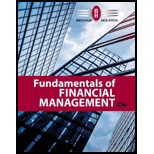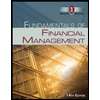
Fundamentals of Financial Management (MindTap Course List)
15th Edition
ISBN: 9781337395250
Author: Eugene F. Brigham, Joel F. Houston
Publisher: Cengage Learning
expand_more
expand_more
format_list_bulleted
Question
Chapter 6, Problem 7Q
a.
Summary Introduction
To explain: The possibility of the savings and loans has the higher interest rates or not.
Introduction:
Interest Rate: A rate at which a borrower is ready to pay and depositor is ready to receive the money is known as interest rate.
Normal Yield Curve: A yield curve which shows the low yield for the short-term bonds and high yield for the long-term debt is known as normal yield curve.
Inverted Yield Curve: A yield curve which shows the high yield for the short-term bonds and low yield for the long-term debt is known as inverted yield curve.
b.
Summary Introduction
To explain: The beneficial situation between to keep the mortgages or to sell out.
Expert Solution & Answer
Want to see the full answer?
Check out a sample textbook solution
Students have asked these similar questions
What is the useful lives for the various types of property, plant, and equipment owned by Airbnb?
What depreciation method does Airbnb employ and how does this depreciation method works?
Does Airbnb have any impaired assets?
New City BandAs the volunteer business manager for the New City Band (City Band), you are responsible for preparing the operating budget for the organization’s upcoming summer concert season. Each year, City Band presents up to 20 weekend performances, depending on weather conditions. The concerts are free to the public,but the band hangs a pot from the bandstand and people leave small donations in it. On average, City Band gets $100 in donations at each of its performances. In addition to donations, New City pays the band $3,000 per season plus $125 for each performance.City Band also has a small endowment of $100,000 on which it expects to earn 3.5 percent in the coming fiscal year. City Band’s trustees have decided to use that money to pay for operating expenses if they need to.City Band pays its conductor $3,000 for the summer season and has aninsurance policy to protect it against any loss of equipment or damage to the bandstand. That policy costs the band $500 for the summer plus…
Chapter 6 Solutions
Fundamentals of Financial Management (MindTap Course List)
Ch. 6 - Prob. 1QCh. 6 - Prob. 2QCh. 6 - Suppose you believe that the economy is just...Ch. 6 - Prob. 4QCh. 6 - Suppose a new process was developed that could be...Ch. 6 - Prob. 6QCh. 6 - Prob. 7QCh. 6 - Suppose interest rates on Treasury bonds rose from...Ch. 6 - Prob. 9QCh. 6 - Suppose you have noticed that the slope of the...
Ch. 6 - YIELD CURVES Assume that yields on U.S. Treasury...Ch. 6 - Prob. 2PCh. 6 - Prob. 3PCh. 6 - DEFAULT RISK PREMIUM A Treasury bond that matures...Ch. 6 - MATURITY RISK PREMIUM The real risk-free rate is...Ch. 6 - INFLATION CROSS-PRODUCT An analyst is evaluating...Ch. 6 - EXPECTATIONS THEORY One-year Treasury securities...Ch. 6 - EXPECTATIONS THEORY Interest rates on 4-year...Ch. 6 - EXPECTED INTEREST RATE The real risk-free rate is...Ch. 6 - INFLATION Due to a recession, expected inflation...Ch. 6 - DEFAULT RISK PREMIUM A companys 5-year bonds are...Ch. 6 - Prob. 12PCh. 6 - Prob. 13PCh. 6 - Prob. 14PCh. 6 - EXPECTATIONS THEORY Assume that the real risk-free...Ch. 6 - INFLATION CROSS-PRODUCT An analyst is evaluating...Ch. 6 - Prob. 17PCh. 6 - YIELD CURVES Suppose the inflation rate is...Ch. 6 - Prob. 19PCh. 6 - INTEREST RATE DETERMINATION AND YIELD CURVES a....Ch. 6 - Prob. 21IC
Knowledge Booster
Similar questions
- What are asset type and the useful lives for a company mean?arrow_forwardWhat was the amount of cash (and cash equivalents) that Airbnb reported for the year of 2024? State the amounts for each item you included in this number. How much working capital does Airbnb have for the year 2024? State the components of working capital and calculations. What is the amount of the total assets that Airbnb reported for the year of 2024 and list the assets?arrow_forwardWhat are Independent Auditors?What is a normal day for a Independent Auditor? What are their responsibilities?arrow_forward
- What was the amount of revenue that Airbnb reported for 2024? Did the revenue grow over the prior year of 2023? What was the dollar and the percentage increase or decrease?arrow_forwardAn annuity provides payments at the end of each two-year period for twenty years. It pays $1,000 at the end of the first period and increases the payment by $1,000 in each subsequent period, so that at the end of the tenth period it pays $10,000. Given a 2% nominal annual interest rate compounded semiannually, determine in which of the following ranges is the present value of this annuity. please use tvm if neededIarrow_forwardA. What is the amount of the annuity purchase required if you wish to receive a fixed payment of $200,000 for 20 years? Assume that the annuity will earn 10 percent per year.B. Calculate the annual cash flows (annuity payments) from a fixed-payment annuity if the present value of the 20-year annuity is $1 million and the annuity earns a guaranteed annual return of 10 percent. The payments are to begin at the end of the current year.C. Calculate the annual cash flows (annuity payments) from a fixed-payment annuity if the present value of the 20-year annuity is $1 million and the annuity earns a guaranteed annual return of 10 percent. The payments are to begin at the end of five years. I need help solving question C on a financial calculator.arrow_forward
- John wants to buy a property for $105,000 and wants an 80 percent loan for $84,000. A lenderindicates that a fully amortizing loan can be obtained for 30 years (360 months) at 6 percentinterest; however, a loan fee of $3,500 will also be necessary for John to obtain the loan.a. How much will the lender actually disburse?b. What is the APR for the borrower, assuming that the mortgage is paid off after 30 years (fullterm)?c. If John pays off the loan after five years, what is the effective interest rate? Why is it differ-ent from the effective interest rate in (b)?d. Assume the lender also imposes a prepayment penalty of 2 percent of the outstanding loanbalance if the loan is repaid within eight years of closing. If John repays the loan after fiveyears with the prepayment penalty, what is the effective interest rate?arrow_forwardIt is now January 1. You plan to make a total of 5 deposits of $500 each, one every 6 months, with the first payment being made today. The bank pays a nominal interest rate of 14% but uses semiannual compounding. You plan to leave the money in the bank for 10 years. Round your answers to the nearest cent. 1. How much will be in your account after 10 years? 2. You must make a payment of $1,280.02 in 10 years. To get the money for this payment, you will make five equal deposits, beginning today and for the following 4 quarters, in a bank that pays a nominal interest rate of 14% with quarterly compounding. How large must each of the five payments be?arrow_forwardDon't used hand raiting and don't used Ai solutionarrow_forward
- Don't used Ai solution and don't used hand raitingarrow_forward(d) Estimate the value of a share of Cisco common stock using the discounted cash flow (DCF) model as of July 27, 2019 using the following assumptions Assumptions Discount rate (WACC) Common shares outstanding 7.60% 5,029.00 million Net nonoperating obligations (NNO) $(8,747) million NNO is negative, which means that Cisco has net nonoperating investments CSCO ($ millions) DCF Model Reported 2019 Forecast Horizon 2020 Est. 2021 Est. 2022 Est. 2023 Est. Terminal Period Increase in NOA FCFF (NOPAT - Increase in NOA) $ 1241 1303 1368 10673 11207 11767 1437 $ 12354 302 ✓ Present value of horizon FCFF 9918 9679 9445 ✔ 0 × Cum. present value of horizon FCFF $ 0 × Present value of terminal FCFF 0 ☑ Total firm value 0 ☑ NNO -8747 ✓ Firm equity value $ 0 ☑ Shares outstanding (millions) 5029 Stock price per share $ 40.05arrow_forwardDon't used hand raiting and don't used Ai solutionarrow_forward
arrow_back_ios
SEE MORE QUESTIONS
arrow_forward_ios
Recommended textbooks for you
 Fundamentals of Financial Management (MindTap Cou...FinanceISBN:9781285867977Author:Eugene F. Brigham, Joel F. HoustonPublisher:Cengage Learning
Fundamentals of Financial Management (MindTap Cou...FinanceISBN:9781285867977Author:Eugene F. Brigham, Joel F. HoustonPublisher:Cengage Learning Fundamentals of Financial Management (MindTap Cou...FinanceISBN:9781337395250Author:Eugene F. Brigham, Joel F. HoustonPublisher:Cengage Learning
Fundamentals of Financial Management (MindTap Cou...FinanceISBN:9781337395250Author:Eugene F. Brigham, Joel F. HoustonPublisher:Cengage Learning Fundamentals Of Financial Management, Concise Edi...FinanceISBN:9781337902571Author:Eugene F. Brigham, Joel F. HoustonPublisher:Cengage Learning
Fundamentals Of Financial Management, Concise Edi...FinanceISBN:9781337902571Author:Eugene F. Brigham, Joel F. HoustonPublisher:Cengage Learning Fundamentals of Financial Management, Concise Edi...FinanceISBN:9781285065137Author:Eugene F. Brigham, Joel F. HoustonPublisher:Cengage Learning
Fundamentals of Financial Management, Concise Edi...FinanceISBN:9781285065137Author:Eugene F. Brigham, Joel F. HoustonPublisher:Cengage Learning Fundamentals of Financial Management, Concise Edi...FinanceISBN:9781305635937Author:Eugene F. Brigham, Joel F. HoustonPublisher:Cengage Learning
Fundamentals of Financial Management, Concise Edi...FinanceISBN:9781305635937Author:Eugene F. Brigham, Joel F. HoustonPublisher:Cengage Learning

Fundamentals of Financial Management (MindTap Cou...
Finance
ISBN:9781285867977
Author:Eugene F. Brigham, Joel F. Houston
Publisher:Cengage Learning

Fundamentals of Financial Management (MindTap Cou...
Finance
ISBN:9781337395250
Author:Eugene F. Brigham, Joel F. Houston
Publisher:Cengage Learning

Fundamentals Of Financial Management, Concise Edi...
Finance
ISBN:9781337902571
Author:Eugene F. Brigham, Joel F. Houston
Publisher:Cengage Learning

Fundamentals of Financial Management, Concise Edi...
Finance
ISBN:9781285065137
Author:Eugene F. Brigham, Joel F. Houston
Publisher:Cengage Learning

Fundamentals of Financial Management, Concise Edi...
Finance
ISBN:9781305635937
Author:Eugene F. Brigham, Joel F. Houston
Publisher:Cengage Learning